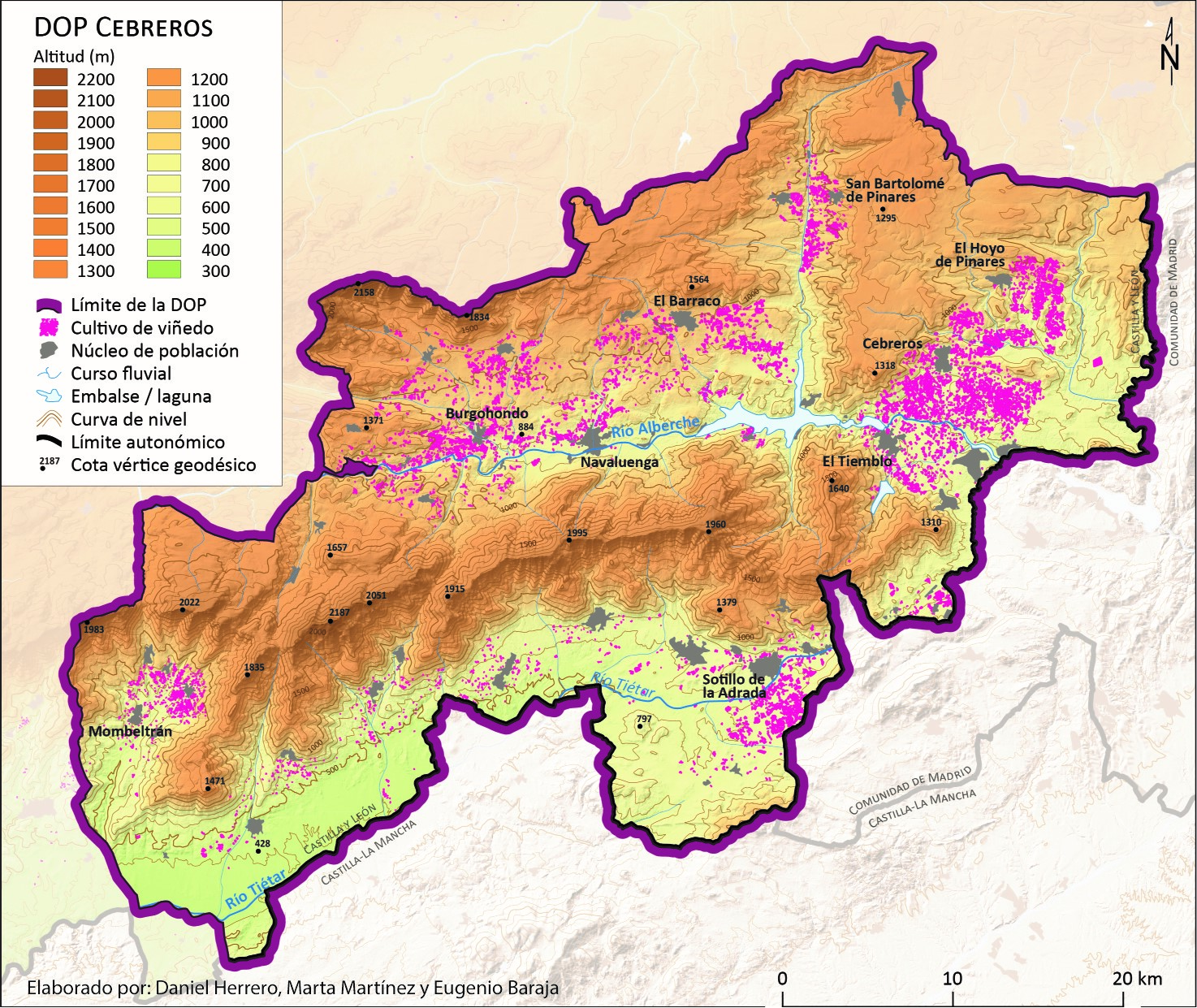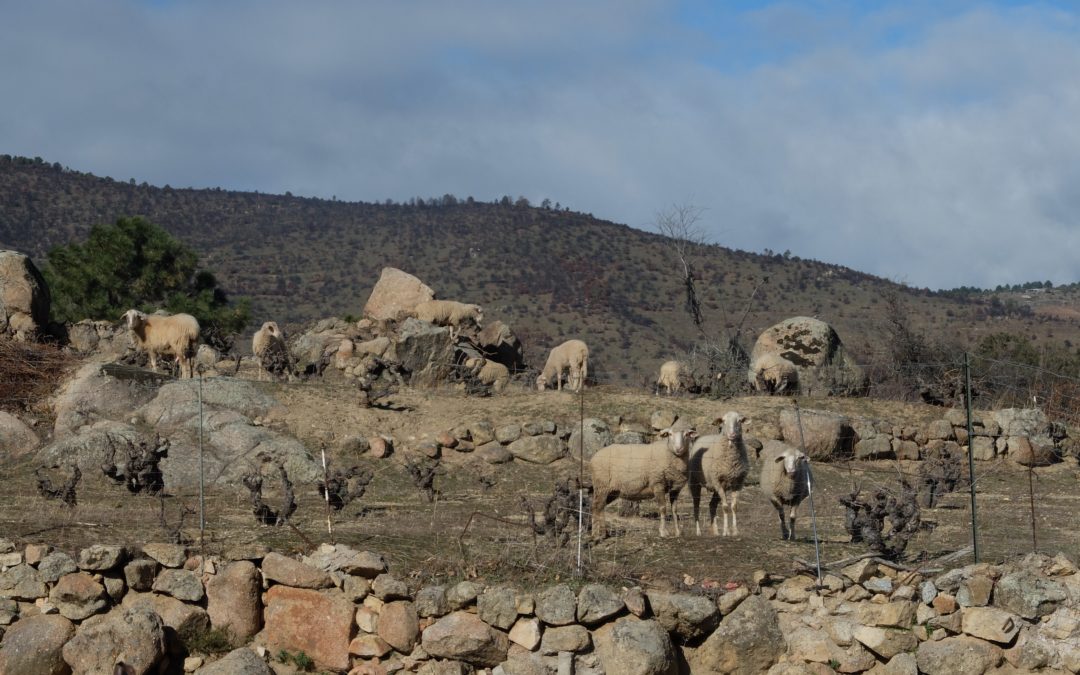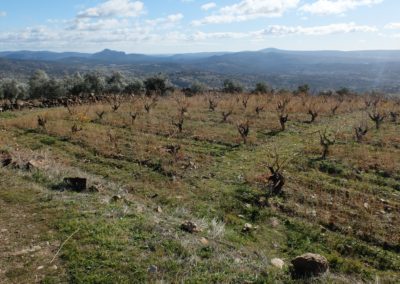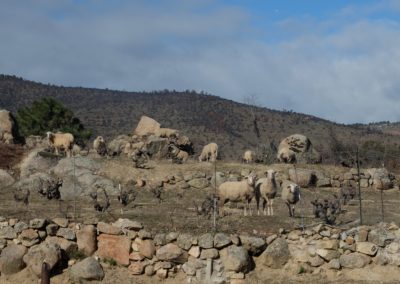Production strategies in areas of singular vitiviniculture: PDO Cebreros (Ávila)
DOI: 10.5281/zenodo.7607468
Mountain and Upland Model
Autores: Eugenio Baraja Rodríguez, Marta Martínez Arnáiz and Daniel Herrero Luque.
Overview of SAMUTER
The secular winegrowing orientation of the southern slopes of the Sierra de Gredos has managed to reach the present day from the logic of subsistence to that of the quality of minority wines produced in unique landscapes. Less damaged by phylloxera than other vineyards, due to the sandy component of the soil, the attachment and tradition of making wine in this mountainous region has sustained the cultivation as a deep-rooted heritage among the local winegrowers, custodians of a significant percentage of old vines, as a distinguishing feature. It is this circumstance of continuity, marginal with respect to the large wine-growing areas, which allowed a progressive recovery of the vineyard in the region of Cebreros from the seventies of the last century and its consolidation until it achieved its own brand of quality based on a new productive and communicative discourse. On the one hand, the values and attributes of the place as a production area: granitic soils, altitudes between 800 and 1000 m, hillside orientations, grape varieties, etc. On the other hand, the landscape, a reference image associated with the singular quality of wines aged in the framework of wine-growing tradition under the prism of innovation and respect for the environment.
1. Environmental sustainability
The revaluation of this area as a producer of singular wines has managed to survive in the context of productivism, in which it does not compete, orienting itself towards the search for a quality of wines that incorporates the environmental and landscape values of the territory in which they are produced as a guarantee. El resurgir de la comarca vitivinícola camina en paralelo a la recuperación de los viñedos viejos – el 94% de las cepas tiene más de 50 años y el 37% más de 80−, lo que implica producciones cortas de buena calidad. The cultivation methods, with wide planting frames and densities of around 1,600 vines/ha, are well aligned with the environmental conditions and are adapted to the requirements of low rainfall and soils poor in organic matter. Multifunctionality, associated with the tourism potential of the sector in the framework of this mountainous landscape at the foot of the Sierra de Gredos Regional Park, is a key element for environmental conservation. For this reason, this aspect is integrated, together with the rest of the heritage values of the territory, at the heart of the cultivation and management of the vine, in the production of the wines and in their commercial presentation.
2. Territoriality and agri-environmental policies
Following a favourable evolution, the wine-growing region of Cebreros, initially integrated in the PGI “Castilla y León”, has been registered as PDO “Cebreros” in 2019. Located in the southeast of the province of Ávila, between the rivers Alberche and Tiétar, it comprises 35 municipalities and a total of 1663.16 km2. The vineyard area is around 450 hectares, while the number of winegrowers exceeds 300. This gives an idea of the micro-parceling of cultivation. Under the protection of the PDO, the story behind the distinction of the wines is based on the environmental quality and the rich biodiversity of these mountain slopes and valleys. The work on the vineyards reinforces these values with the promotion of agro-ecological practices. The context of opportunity that encourages the PDO as an area of singular viticulture rests on scarce productions and differentiated elaborations with reference to physical factors, environmental sustainability and the landscape as a compendium of quality and an asset for wine tourism development. The value of the wine-growing heritage received is highlighted and vineyard management is integrated into the tasks of “environmental stewardship”. Likewise, the ruggedness of the terrain establishes differences in soils, altitudes and exposures that fill mountain wines with nuances. For this reason, the local typicity of smaller geographical units is considered in the search for a wine-growing fragmentation that is more in tune with the territorial uniqueness of the PDO.
3. Relations between production, processing, marketing and consumption
Vineyards and wineries share territory. If the winemaking tradition supports it, the PDO obliges it. La juventud de la DOP «Cebreros» se manifiesta en el auge de las bodegas incorporadas a ella y en el entusiasmo de los nuevos proyectos: de 14 en su comienzo (campaña 2019/20) a 20 en la campaña 2021/22. The rooting and recovery of the family plots, together with the opportunity to produce different wines, are the reasons given for their establishment, generating some virtuous socio-economic dynamics in the host villages. Based on these production bases of nuanced and unique wines, the classic markets for Cebreros wine – Avila, Madrid – are being expanded in an attempt to penetrate select distribution circuits, both domestic and export.
4. Good governance
The PDO and its regulations protect the quality of Cebreros wines. However, the restrictions imposed by the specifications set limits that are perceived as excessive for the aspirations of some wineries, especially for a young appellation that was born at a time when the creative freedom of winemakers within the appellations is a common clamour. The case of this PDO, recently registered but with a long history of production, can be, due to its size and characteristics, a good laboratory to evaluate the current functional governance of PDOs conceived under classic schemes in a context of a certain rebelliousness with respect to what a territorial quality figure should certify.
Another issue for the governance debate arises here because of the distortion posed by political-administrative divisions in the territorial marking of food. The regional boundary as an argument for delimiting the territorial brand is poorly justified in neighbouring areas with a similar wine-growing tradition and history. The PDOs “Méntrida” (Castilla-La Mancha), “Vinos de Madrid” (Madrid) and “Cebreros” (Castilla y León) are the case of a separation motivated by regional boundaries that becomes a frustration for some winemakers with vineyards and/or wineries located on either side.






Recent Comments